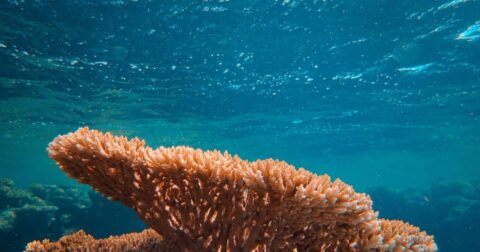Explainer
Agriculture Affects Deforestation Much More Than Most People Realize
Climate•7 min read
Reported
According to a 20-year study in Nature, reefs closer to pollution fared worse in recovering from damage caused by climate change.


Words by Grace Hussain
Right now a visit to Florida’s famous beaches is akin to taking a dip in a hot tub — with water temperatures in some places reaching into the 100s. The piping hot seas are enough to dissuade tourists from taking a dip, but there are other, more worrying dangers too. Rising temperatures are damaging coral reefs — 14 percent have already been lost since 2009. What’s worse, human activities like overfishing and aquaculture are helping fuel the destruction.
A new study published in the journal Nature highlights the damage pollution hotspots can cause these critically important species. Using data collected over 20 years off the coast of Hawai’i, researchers tracked how coral reefs fared as temperatures spiked. What they found was that those closer to pollution sources like aquaculture had fewer fish and were also less resilient to hot water.
Researchers could not have predicted the timeliness of their data collection but it turned out to be prescient. In 2015 reefs in Hawai’i were faced with abnormally hot water temperatures, so the researchers were able to track not only how the reefs were affected but also to measure their recovery in the years that followed.
Whereas healthy reefs have bright colors and diverse marine life, degraded reefs are duller, tend to be broken in more places and may even be bleached white.
For twelve years prior to and four years after the marine heatwave, researchers studied how reefs in different areas fared. What they found was that those closest to sources of pollution — like sewage pipes and aquaculture — were already on the decline before the heatwave. These reefs were then harder hit by the higher temperatures and were slower to recover. Meanwhile, in less polluted areas, reefs fared better — thanks to their cleaner waters and healthier, thriving fish populations.
In other words, curbing sources of pollution, such as factory farming, enables us to not only reduce animal suffering and greenhouse gas emissions, but also contributes to healthier coral reefs.
In Hawai’i, major contributors to water pollution are wastewater, sewage, erosion and agriculture. Though the current study focused on other sources of water pollution, animal agriculture plays a major role in water pollution and its damaging after-effects, like the destruction of coral reefs.
One of Hawai’i’s major agricultural industries is aquaculture, which reached a record worth of $79.7 million in 2021, an increase of 20 percent over the previous year. In Hawai’i state waters are leased to private companies for aquaculture within 3 miles of shore. Tilapia, catfish and ornamental fish are among the species of fish currently farmed, but the state is also notorious for being the location of one of the world’s first octopus farms.
Though an often overlooked source of pollution, fish farms have been linked to considerable ecological destruction. Aquaculture operations are able to release pollutants directly into the water. According to a Friends of the Earth report, the waste from one facility is equivalent to the raw sewage of 20,000 people which contributes high levels of excess nutrients to the water.
The phosphorus, nitrates, nitrites and other nutrients that enter the water can prove deadly to numerous species, including coral reefs, encouraging algal blooms that block out light and use up all the oxygen in the water.
Factory farming on land also contributes heavily to water pollution. The animals produce massive amounts of fecal matter — for example, an average of 12 tons per cow per year — which runs off into smaller bodies of water or enters the groundwater. Eventually, this water makes its way back into the ocean.
Not only are coral reefs home to numerous species, they also protect coastlines, support local economies and play an essential role in a healthy ocean food web helping biodiverse groups of marine life thrive.
Coral reefs are some of the most biodiverse places on earth. The Great Barrier Reef — which is adjacent to the shore and draws roughly 5 million visitors a year — plays host to 9,000 known species. Many of these species, such as green sea turtles, are listed as endangered under the Endangered Species Act.
It’s not just fish and other marine life that rely on coral reefs; we do too. Estimates suggest that coral reefs are responsible for $375 billion worth of goods and services per year. Coral reefs are tourism power houses — a healthy Great Barrier Reef in Australia supports more than 58,000 jobs, for instance.
Reefs don’t just help tourism-based economies flourish, they also provide important risk mitigation. Stateside, coral reefs provide more than $1.8 billion in flood risk reduction by acting as a barrier between coastal communities and the sea.
Today, 25 different species of coral are listed under the Endangered Species Act. In order to protect not just those but all 6000 species of coral, policymakers need to act, the study’s senior author Dr. Greg Asner told Phys.
For Asner, policy change is a necessary part of the solution: “…Only by adopting coupled land-sea policy measures, alongside global reductions in greenhouse gas emissions, will coral reef ecosystems…have the best opportunity for persistence in our changing climate.”